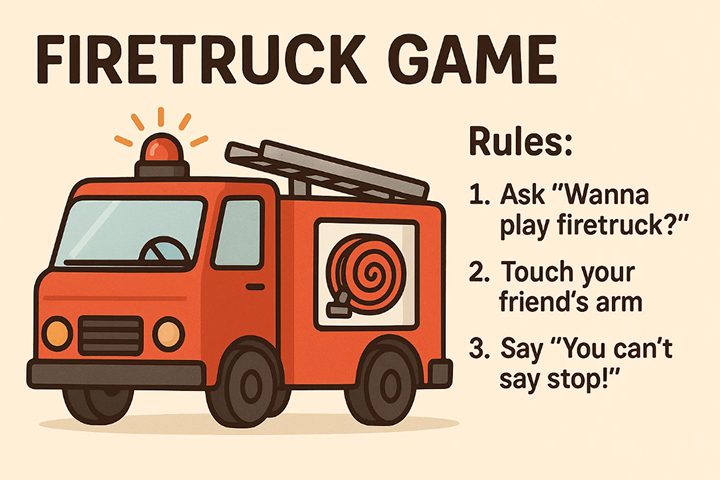What is the Firetruck game? Due to its popularity, as a curiosity and concern, inducing play activity, parents and educators have gained interest in this trending activity. At first glance, the game seems quite harmless as children behave like firefighters rushing to an emergency. However, is it really as safe when played in an online environment?
In this article, we are going to examine the rules, risks and rewards of the Firetruck game. So as to see if it is worth playing or if it is a risky game.
What is the Firetruck game?
In its original form, the firetruck game was a simple, imaginative play activity enjoyed by children on playgrounds. Typically, one child played as a firetruck or firefighter, imitating siren sounds and running around other children, who served as obstacles, such as buildings or other vehicles. The game reflected children’s cultural fascination with emergency services, based on its design from the heroic imagery of firefighters and their vehicles.



While its origins are not precisely documented, it is probably one of the early 20th-century childhood games. These games mirrored societal roles, with the firetruck becoming iconic. This early version of the game didn’t have any malicious intent. It was about being cooperative and encouraging teamwork and creativity.
What distinguishes the Firetruck game from organized sports is that it thrives on spontaneity, making it a schoolyard and neighborhoods favourite.
How has the traditional Firetruck game evolved?
The firetruck game was initially a wholesome game, acting as a reflection of a simpler time in play structures, illustrating an admiration for firefighters.As the urban environments grew and the technology of firefighting developed from steam powered engines to more modern trucks. Children’s games naturally included these elements.
Unfortunately, however, in recent decades, things turned into a darker direction for the firetruck game. Gaining a new meaning on social media platforms like TikTok. In this modern version, one person places their hand on another’s (usually a woman’s) inner thigh. And moves upward, with the recipient saying “red light” to stop the action. Disturbingly, the initiator can respond by saying “firetrucks don’t stop at red lights” and keeps on going, effectively ignoring consent.
This version, first documented as early as 2011, has been widely criticized as a pretext for sexual harassment or assault among teens.
Why is Firetruck game popular among teens?
There are many reasons why “firetruck game” is so popular among some teenagers.
Many of these reasons have to do with several important aspects of adolescent psychology and social dynamics.
- Thrill-seeking and boundary testing. The evolved ‘firetruck game’ might be illicit and, potentially shocking. But exciting for adolescents who have a greater drive for novel and exciting experiences.
- Peer influence and social conformity. Teens are very susceptible to peer pressure and are likely to participate in risky behaviors, to gain acceptance and avoid exclusion.
- Social media trends and viral challenges. Such a ‘game’ while controversial, can quickly go viral through shares, challenges, etc., as people want online attention or notoriety.
- Seeking attention and reactions. Some teenagers use controversial or taboo activities as a way to get attention, provoke reactions or set up an identity.
Being able to recognize why it’s popular to some teens is important. For parents to deal with the issue effectively and build a culture of respect and consent.
Ensure a safe online environment for teens with the parental control.
How is the innocent version of Firetruck game played?
What is the Firetruck game, used to be wholesome and imaginative for younger kids, before the chaotic teen versions took over.
The classic version was a cooperative game focused on play, creativity and light physical activity (no roughhousing required). Here’s how it was traditionally played.
- Form the firetruck. A human firetruck is made when kids form a row line each placing their hands on the shoulder of the person in front of them.
- Assign roles. In this exercise, the “driver” (front of the line) is one child, others can be firefighters, and someone may act as if holding a “hose.”
- Sound the siren. As the group moves together, the group makes fire engine noises (e.g. “Wee-oo-wee-oo!”).
- Respond to emergencies. The ‘fire truck’ rushes around ‘extinguishing fires’ (chalking, marking or visually spots).
- Rescue missions. Kids can make ‘saves’ of stuffed animals, dolls, even a friendly volunteer (softly!).
Whereas the controversial social media version involves non consentual touch, the innocent version is about creative problem-solving and active play.
This wholesome version, which predates and is completely different from the boundary crossing trend, is not associated with social media platforms.
Is the changed version of Firetruck game appropriate for minors?
Whether or not what is the firetruck game is suitable for minors solely depends on which version you are referring to. The innocent, traditional firetruck game, in which children play firefighter or a firetruck, pretending to use sirens and saving imaginary victims, is perfectly appropriate for children. This version encourages teamwork, creativity and a sense of community helpers. Which makes it a safe and enjoyable kid’s activity during play time or in the classroom.
However, the modern, controversial version of the firetruck game is unquestionably inappropriate for minors as it is non-consensual and potentially predatory.
The risks and concerns associated with the Firetruck game
When the Firetruck game evolves beyond innocent teasing into more adult oriented or sexualized versions, this is a very serious red flag.
Here are some of the dangers of the evolved firetruck game.
- Normalization of non-consensual touch. Making unwanted touching a “game” can desensitize people on the need for consent and how to respect personal boundaries.
- Increased risk of sexual harassment and assault. The more the “game” progresses and the closer you get to private areas. This is sexual harassment and can turn into sexual assault.
- Psychological harm. Victims can feel violated, ashamed, fearful and anxious. Such can lead to long-lasting negative impact on their mental health and well being.
- Erosion of trust. It can hurt trust between peers and make the social environment hostile.
- Misinformation and lack of education. This popular trend shows a possible ignorance on the part of some teenagers about consent, healthy relationships and the seriousness of sexual harassment.
The presence of such content highlights the urgent need for education, openness of communication, and clear boundaries for minors to avoid harm.
What parents should do if their teen is playing the sexualized version of Firetruck game?
There is nothing more upsetting to any parent than to discover that their teenager is a part of the sexualized version of the firetruck game.
This situation has to be addressed with sensitivity, understanding, and education while ensuring safety. For parents this is a guide what to do.
1. Initiate open communication
- Avoid immediate anger or accusations. They may begin to defend themselves and shut down. Try to talk to them in a composed way and simply state your concern about their well being.
- Select a private and comfortable place. It will help to lead to a more open and honest discussion on the issue.
- Listen actively. Listen for what they say, what they ‘think the game’ is, and why they are playing or have heard about it. Look into the peer dynamics involved.
2. Educate about consent and boundaries
- Clearly explain what consent means. Make the point that “firetrucks don’t stop” is a dangerous and unacceptable idea when it comes to physical interaction.
- Discuss personal boundaries. Assist in making your teen realize the value of respecting themselves and others’ boundaries.
- Playful teasing vs harmful behavior. Remind them that the sexualized version of the firetruck game is not innocent fun, but rather, can be sexual harassment or even sexual assault.
- Discuss legal and emotional consequences. Teach them the seriousness of non-consensual touching.
3. Use parental controls
Parental control tools will track your teen’s activity online, restrict access to inappropriate content, and foster wholesome digital practices.
FlashGet Kids is one of the best parental control apps for protecting minors online. It provides strong safety features both online and offline.
It offers its users several features that woud help in the following ways.



- Screen Mirroring. Enables you to view your teen’s screen in real time so you can watch them on their device to detect if there is any suspicious behavior.
- Daily Usage Reports. It gives you detailed insights about how much your teen spends on different apps so that it becomes easier for you to find out about the exposure to the content which is inappropriate.
- App Blocker. It allows you to block access to certain apps or games, and to games linked with all kinds of risky trends or explicit material such as fire truck game porn.
- Alerts. It sends instant notifications if the teen tries to reach any blocked content or engages with any potentially harmful activities online.
Combining open communication with an effective digital tool such as FlashGet Kids. Parents can make their teens safer online and help them make responsible choices.
Wrap up
Understanding what is the Firetruck game shows that although it may be a simple humorous game. It can easily become vulgar – particularly in the online context. When playfulness becomes linked with risky activities, it is apparent that this trend deserves more than just a fleeting look.
Parents should play an active role in their children’s lives and ensure that they monitor their children’s interaction. Both on the social media and in the physical world. Such tools as FlashGet Kids provide features like screen mirroring, apps blocking, and real-time notifications. To assist in safeguarding your child when online.

